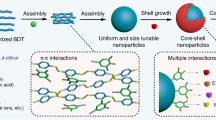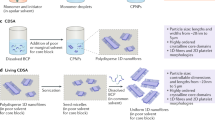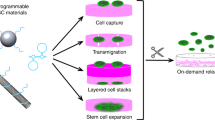Abstract
Systems in which nanoscale components of different types can be captured and/or released from organic scaffolds provide a fertile basis for the construction of dynamic, exchangeable functional materials. In such heterogeneous systems, the components interact with one another by means of programmable, noncovalent bonding interactions. Herein, we describe polymers that capture and release functionalized nanoparticles selectively during redox-controlled aggregation and disaggregation, respectively. The interactions between the polymer and the NPs are mediated by the reversible formation of polypseudorotaxanes, and give rise to architectures ranging from short chains composed of few nanoparticles to extended networks of nanoparticles crosslinked by the polymer. In the latter case, the polymer/nanoparticle aggregates precipitate from solution such that the polymer acts as a selective ‘sponge’ for the capture/release of the nanoparticles of different types.
This is a preview of subscription content, access via your institution
Access options
Subscribe to this journal
Receive 12 print issues and online access
$259.00 per year
only $21.58 per issue
Buy this article
- Purchase on Springer Link
- Instant access to full article PDF
Prices may be subject to local taxes which are calculated during checkout





Similar content being viewed by others
References
Balzani, V., Venturi, M. & Credi, A. Molecular Devices and Machines: Concepts and Perspectives for the Nanoworld (Wiley, 2008).
Kay, E. R., Leigh, D. A. & Zerbetto, F. Synthetic molecular motors and mechanical machines. Angew. Chem. Int. Ed. 46, 72–191 (2007).
Pease, A. R. et al. Switching devices based on interlocked molecules. Acc. Chem. Res. 34, 433–444 (2001).
Klajn, R., Bishop, K. J. M. & Grzybowski, B. A. Light-controlled self-assembly of reversible and irreversible nanoparticle suprastructures. Proc. Natl Acad. Sci. USA 104, 10305–10309 (2007).
Klajn, R. et al. Metal nanoparticles functionalized with molecular and supramolecular switches. J. Am. Chem. Soc. 131, 4233–4235 (2009).
van Delden, R. A. et al. Unidirectional molecular motor on a gold surface. Nature 437, 1337–1340 (2005).
Tretiakov, K. V., Bishop, K. J. M. & Grzybowski, B. A. The dependence between forces and dissipation rates mediating dynamic self-assembly. Soft Matter 5, 1279–1284 (2009).
Fialkowski, M. et al. Principles and implementations of dissipative (dynamic) self-assembly. J. Phys. Chem. B 110, 2482–2496 (2006).
Grzybowski, B. A. et al. Self-assembly: from crystals to cells. Soft Matter 5, 1110–1128 (2009).
Saha, S. et al. Nanovalves. Adv. Funct. Mater. 17, 685–693 (2007).
Nguyen, T. D. et al. Design and optimization of molecular nanovalves based on redox-switchable bistable rotaxanes. J. Am. Chem. Soc. 129, 626–634 (2007).
Nguyen, T. D. et al. Construction of a pH-driven supramolecular nanovalve. Org. Lett. 8, 3363–3366 (2006).
Ferris, D. P. et al. Light-operated mechanized nanoparticles. J. Am. Chem. Soc. 131, 1686–1688 (2009).
Zhu, Y. C. & Fujiwara, M. Installing dynamic molecular photomechanics in mesopores: A multifunctional controlled-release nanosystem. Angew. Chem. Int. Ed. 46, 2241–2244 (2007).
Tanaka, T., Ogino, H. & Iwamoto, M. Photochange in pore diameters of azobenzene-planted mesoporous silica materials. Langmuir 23, 11417–11420 (2007).
Klajn, R., Bishop, K. J. M., Wesson, P. J. & Grzybowski, B. A. Writing self-erasing images using metastable nanoparticle ‘inks’. Angew. Chem. Int. Ed. 48, 7035–7039 (2009).
Korth, B. D. et al. Polymer-coated ferromagnetic colloids from well-defined macromolecular surfactants and assembly into nanoparticle chains. J. Am. Chem. Soc. 128, 6562–6563 (2006).
Skaff, H., Ilker, M. F., Coughlin, E. B. & Emrick, T. Preparation of cadmium selenide-polyolefin composites from functional phosphine oxides and ruthenium-based metathesis. J. Am. Chem. Soc. 124, 5729–5733 (2002).
Watson, K. J., Zhu, J., Nguyen, S. T. & Mirkin, C. A. Hybrid nanoparticles with block copolymer shell structures. J. Am. Chem. Soc. 121, 462–463 (1999).
Anelli, P. L. et al. Self-assembling [2]pseudorotaxanes. Angew. Chem. Int. Ed. Engl. 30, 1036–1039 (1991).
Ashton, P. R. et al. Thermodynamically controlled self-assembly of pseudorotaxanes and pseudopolyrotaxanes with different recognition motifs operating self-selectively. Angew. Chem. Int. Ed. Engl. 35, 1930–1933 (1996).
Ashton, P. R. et al. The self-assembly of complexes with [2]pseudorotaxane superstructures. Chem. Commun. 1680–1683 (1991).
Northrop, B. H., Khan, S. J. & Stoddart, J. F. Kinetically controlled self-assembly of pseudorotaxanes on crystallization. Org. Lett. 8, 2159–2162 (2006).
Boal, A. K. et al. Self-assembly of nanoparticles into structured spherical and network aggregates. Nature 404, 746–748 (2000).
Shenhar, R., Norsten, T. B. & Rotello, V. M. Polymer-mediated nanoparticle assembly: structural control and applications. Adv. Mater. 17, 657–669 (2005).
Maye, M. M., Chun, S. C., Han, L., Rabinovich, D. & Zhong, C. J. Novel spherical assembly of gold nanoparticles mediated by a tetradentate thioether. J. Am. Chem. Soc. 124, 4958–4959 (2002).
Paciotti, G. F. et al. Colloidal gold: A novel nanoparticle vector for tumor directed drug delivery. Drug Deliv. 11, 169–183 (2004).
Han, G. et al. Light-regulated release of DNA and its delivery to nuclei by means of photolabile gold nanoparticles. Angew. Chem. Int. Ed. 45, 3165–3169 (2006).
Liong, M. et al. Multifunctional inorganic nanoparticles for imaging, targeting, and drug delivery. ACS Nano 2, 889–896 (2008).
Olson, M. A. et al. A bistable poly[2]catenane forms nanosuperstructures. Angew. Chem. Int. Ed. 48, 1792–1797 (2009).
Philp, D. et al. The complexation of tetrathiafulvalene by cyclobis(paraquat-para-phenylene). Chem. Commun. 1584–1586 (1991).
Ballardini, R. et al. A photochemically driven molecular machine. Angew. Chem. Int. Ed. Engl. 32, 1301–1303 (1993).
Jana, N. R. & Peng, X. G. Single-phase and gram-scale routes toward nearly monodisperse Au and other noble metal nanocrystals. J. Am. Chem. Soc. 125, 14280–14281 (2003).
Klajn, R. et al. Plastic and moldable metals by self-assembly of sticky nanoparticle aggregates. Science 316, 261–264 (2007).
Klajn, R. et al. Bulk synthesis and surface patterning of nanoporous metals and alloys from supraspherical nanoparticle aggregates. Adv. Funct. Mater. 18, 2763–2769 (2008).
Klajn, R., Pinchuk, A. O., Schatz, G. C. & Grzybowski, B. A. Synthesis of heterodimeric sphere-prism nanostructures via metastable gold supraspheres. Angew. Chem. Int. Ed. 46, 8363–8367 (2007).
Witt, D., Klajn, R., Barski, P. & Grzybowski, B. A. Applications properties and synthesis of omega-functionalized n-alkanethiols and disulfides – the building blocks of self-assembled monolayers. Curr. Org. Chem. 8, 1763–1797 (2004).
Houk, K. N. et al. [C-H···O] interactions as a control element in supramolecular complexes: Experimental and theoretical evaluation of receptor affinities for the binding of bipyridinium-based guests by catenated hosts. J. Am. Chem. Soc. 121, 1479–1487 (1999).
Raymo, F. M., Bartberger, M. D., Houk, K. N. & Stoddart, J. F. The magnitude of [C-H···O] hydrogen bonding in molecular and supramolecular assemblies. J. Am. Chem. Soc. 123, 9264–9267 (2001).
Flory, P. J. Molecular size distribution in three-dimensional polymers. I. Gelation. J. Am. Chem. Soc. 63, 3083–3090 (1941).
Stockmayer, W. H. Theory of molecular size distribution and gel formation in branched-chain polymers. J. Chem. Phys. 11, 45–55 (1943).
Kalsin, A. M. et al. Electrostatic self-assembly of binary nanoparticle crystals with a diamond-like lattice. Science 312, 420–424 (2006).
Kalsin, A. M. et al. Ionic-like behavior of oppositely charged nanoparticles. J. Am. Chem. Soc. 128, 15046–15047 (2006).
de Gennes, P. G., Pincus, P., Velasco, R. M. & Brochard, F. Remarks on polyelectrolyte conformation. J. Phys. Paris 37, 1461–1473 (1976).
Dobrynin, A. V., Colby, R. H. & Rubinstein, M. Scaling theory of polyelectrolyte solutions. Macromolecules 28, 1859–1871 (1995).
Asakawa, M. et al. A chemically and electrochemically switchable [2]catenane incorporating a tetrathiafulvalene unit. Angew. Chem. Int. Ed. 37, 333–337 (1998).
de Jongh, P. E., Vanmaekelbergh, D. Trap-limited electronic transport in assemblies of nanometer-size TiO2 particles. Phys. Rev. Lett. 77, 3427–3430 (1996).
Wuelfing, W. P., Green, S. J., Pietron, J. J., Cliffel, D. E. & Murray, R. W. Electronic conductivity of solid-state, mixed-valent, monolayer-protected Au clusters. J. Am. Chem. Soc. 122, 11465–11472
Nakanishi, H. et al. Photoconductance and inverse photoconductance in films of functionalized metal nanoparticles. Nature 460, 371–375 (2009).
Credi, A. et al. Simple molecular-level machines. Interchange between different threads in pseudorotaxanes. New J. Chem. 22, 1061–1065 (1998).
Acknowledgements
The research was supported by the Microelectronics Advanced Research Corporation and its Focus Center of Functional Engineered NanoArchitectonics. B.A.G. gratefully acknowledges the financial support from the Alfred P. Sloan Fellowship and from The Dreyfus Teacher-Scholar Award. Development of theoretical models was supported by the Non-equilibrium Energy Research Center an Energy Frontier Research Center funded by the US Department of Energy, Office of Science, Office of Basic Energy Sciences under award number DE-SC0000989. R.K. was supported by the NSF under the Northwestern MRSEC. L.F. gratefully acknowledges the support of the Ryan Fellowship at Northwestern University.
Author information
Authors and Affiliations
Contributions
B.A.G. and J.F.S. conceived the project and prepared the manuscript. M.A.O. synthesized polymer 14n+. L.F., A.C. and M.A.O. synthesized dithiolane ligands for nanoparticles. R.K. synthesized and functionalized nanoparticles and prepared nanoparticle–polymer complexes. P.J.W. and S.S. developed theoretical models. A.T. performed electrochemical experiments.
Corresponding authors
Supplementary information
Supplementary information
Supplementary information (PDF 945 kb)
Rights and permissions
About this article
Cite this article
Klajn, R., Olson, M., Wesson, P. et al. Dynamic hook-and-eye nanoparticle sponges. Nature Chem 1, 733–738 (2009). https://doi.org/10.1038/nchem.432
Received:
Accepted:
Published:
Issue Date:
DOI: https://doi.org/10.1038/nchem.432
This article is cited by
-
Radical organometallic nanocages with redox switchable poly-NHC ligands
Nano Research (2023)
-
Independent Multi-states of Photo-responsive Polymer/Quantum Dot Nanocomposite Induced via Different Wavelengths of Light
Scientific Reports (2019)
-
Orthogonal switching of a single supramolecular complex
Nature Communications (2012)
-
Recognition-mediated activation of therapeutic gold nanoparticles inside living cells
Nature Chemistry (2010)
-
A ‘Texas-sized’ molecular box that forms an anion-induced supramolecular necklace
Nature Chemistry (2010)



